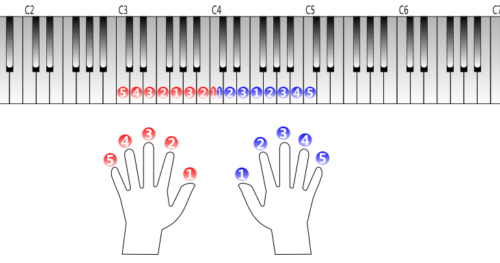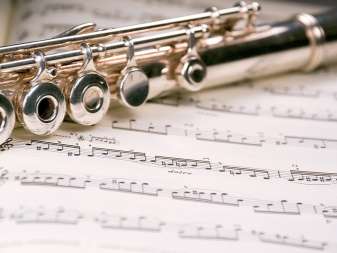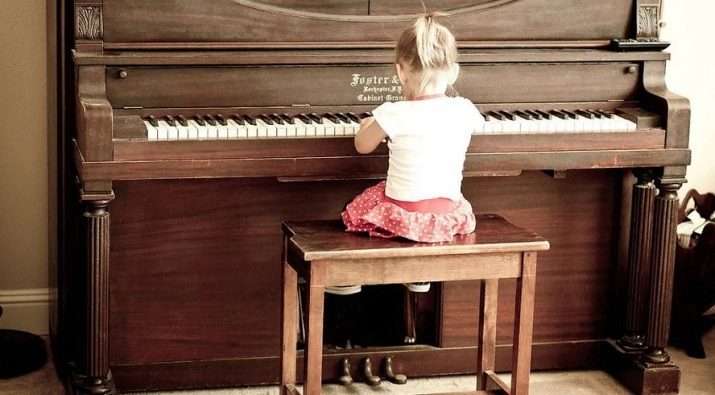
How to learn to play the organ?
Contents
In any ranking regarding the difficulty of learning to play a musical instrument, the organ rightfully ranks first. There are very few good organists in our country, and only a few of high-class ones. It is worth clarifying that the conversation is now about wind instruments, which in the old days were installed in temples or rich mansions. But even on modern models (purely electronic or electromechanical), learning to play is also quite difficult. About the features of learning on the organ, playing technique and other nuances that beginner organists have to overcome, are described in the article below.
Learning Features
The main feature of playing the organ is that the musician must act not only with his hands on the manual keyboard in several rows, but at the same time with his feet.
Learning to play a classical wind instrument (church, theatrical or orchestral) should be started only after the piano keyboard has been perfectly mastered. You can learn to play the electric organ from scratch.

In music schools (far from all) and colleges, future organists are taught on small electric organs that have both manuals (a multi-row manual keyboard) and foot pedals. That is, the musician has the whole set of devices for playing music, similar to a large organ, but the sounds are created through a combination of mechanics and electronics, or only with the help of electronics.
Professional pianists can get lessons in playing the classical organ either from experienced organists at churches, concert halls, theaters that have serious instruments. And also in large cities there will always be some communities of organists, where there will definitely be those who will help fellow musicians master this interesting instrument.
Landing and positioning of hands
Seating for a beginner organist is of paramount importance, as there are many things to consider:
- general convenience of placement behind the instrument;
- freedom of action of arms and legs;
- the possibility of full coverage of the keyboard and pedals;
- register lever control.

You should sit at some distance from the keyboard on a bench carefully adjusted for height and other personal anatomical features of the musician. A landing too close to the keyboard will limit the musician’s freedom of movement, especially with his feet, and too far will not allow him to reach the remote rows of the manual or force him to reach for them, which is unacceptable and tiring during long music lessons.
You need to sit on the bench straight and approximately in the middle of the hand keyboard. Feet should reach the pedals, which are the same keyboard, but only much larger than the manual one.
The fit should give the arms a roundness, not an elongation. At the same time, the elbows are slightly spaced to the side of the body, in no case hanging down.
It is worth noting that the bodies do not have any standards. Only modern factory electric organs can have them, and even then only within one serial model of a particular manufacturer. Therefore, with the seriousness of training plans, it is necessary to familiarize yourself with different types of instruments in order to be ready for anything: there can be three, five, or seven manuals, foot pedals are also not tied to a certain number, registers depend on the dimensions of the instrument, and so on.

There are countless options, including among classical organs, which, by the way, are still being built in large temples and concert halls. In less significant churches and music halls, they mostly manage with electric organs, since they cost hundreds of times cheaper than classical ones, and they don’t need much space.
Work on coordination
Coordination of movements of hands and feet during the performance of organ music is developed gradually – from lesson to lesson. According to the organists themselves, this is not particularly difficult if the lessons on mastering the instrument follow a certain program, in which the practice of playing is built according to the scheme from simple to complex. The same thing happens exactly when developing the game, first with one hand on the piano or, for example, button accordion, and then with both at the same time. The only difficulty is only the performance on an unfamiliar organ, in which the foot pedals not only have a different range, but are also structurally located differently (parallel or radial arrangement).
From the very beginning, when it comes to connecting hands and feet, students learn to play without looking at the footpad. At the same time, they bring their actions to automatism with long training sessions.
The complexity of the work when working out the coordination of the actions of the hands lies also in the peculiarity of the organ that the sound of a particular key on the keyboard disappears immediately after it is released. In the piano, it is possible to prolong the sound of notes by pressing the right pedal, and in the organ, the sound lasts as long as the channel through which the air moves through is open. When the valve is closed after releasing the key, the sound immediately cuts off. To play several notes in a connected (legato) or to delay the duration of individual sounds, you need a very good ear and the ability to coordinate the playing of individual fingers to produce connected or long notes, while not delaying short ones.
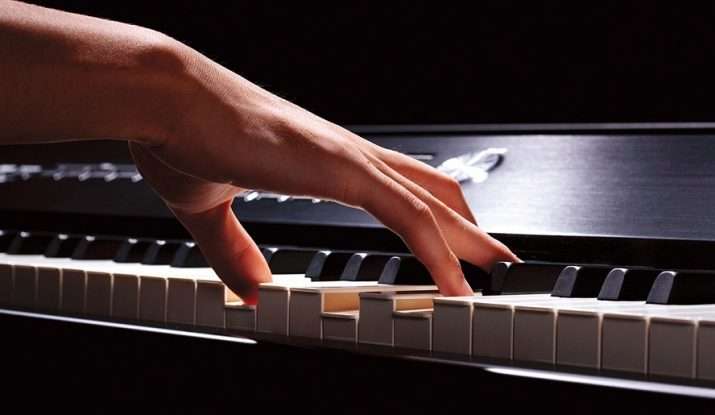
Coordination of auditory perception of sounds and their extraction must be developed at the beginning of the pianist’s journey. To do this, during practical lessons with the piano, one should often turn to the student’s musical ear, training the ability to mentally imagine any sounds, and then get their sound on the instrument.
Game technique
The technique of playing hands on the organ is similar to the pianoforte, which is why it is pianists who most often switch to the organ or combine these two directions in their musical career. But still, the property of organ sounds to instantly disappear after releasing the key obliges pianists to master several purely organ articulatory manual techniques associated with legato (and other techniques close to it) or, conversely, abruptness of playing the instrument.
In addition, several manuals also impose their own characteristics on the organist’s playing technique: often one has to play simultaneously on different rows of the organ keyboard. But for experienced pianists, such a task is quite within the power.
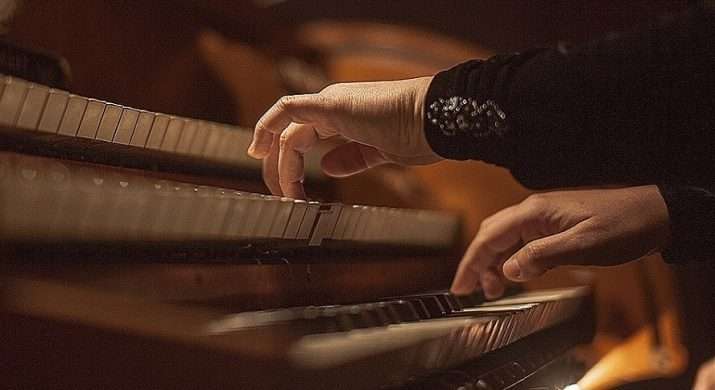
Playing with your feet, of course, will be an innovation even for professional keyboardists, and not just for musicians of other directions. Here they will have to work hard. Pianists are only familiar with piano pedals, but a serious organ can have from 7 to 32 such pedals. In addition, they themselves make sounds, and do not indirectly affect those played by manual keys (this is exactly what happens on the piano).
Playing on the foot keyboard can be done either with just the toes of the shoes, or with both socks and heels, or with just the heels. It depends on the type of organ. For example, on a baroque organ, which has the so-called block foot keyboard system, it is impossible to play only with socks – it has keys for both the toe part of the shoe and the heels. But many of the old organs, common in the Alpine region of Western Europe, usually have a short foot keyboard, which is played exclusively with socks. By the way, such a keyboard is often used on modern electronic organs.
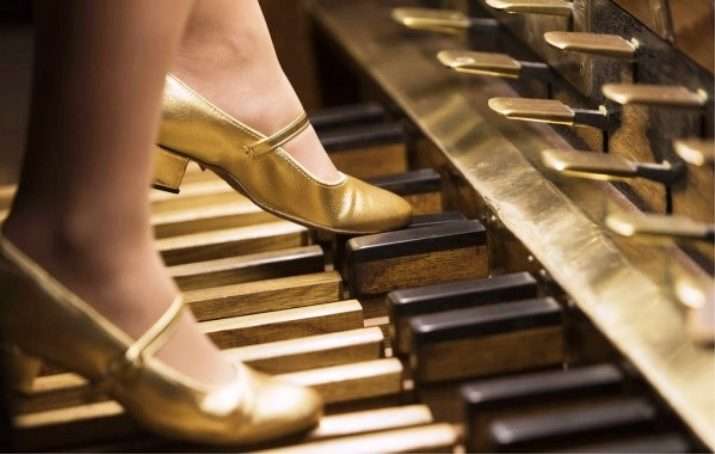
The main kicking techniques are:
- alternately pressing the keys with a toe and a heel;
- simultaneous pressing of two keys with a toe and a heel;
- sliding the foot to adjacent or more distant pedals.
To play the organ, special shoes are used, which are sewn to order. But many use dance shoes with heels. There are also organists who play without shoes (in socks).

Foot fingering is indicated in the musical literature for the organ by a variety of signs that are not brought to any single standard.
Recommendations
From all that has been said above, a number of recommendations can be drawn for beginners in learning to play the organ. They will be useful to everyone – both those who already play the piano, and those who sit down at the electric organ from scratch.
- Find an experienced teacher who has the right to teach the organ.
- Buy an instrument or agree on the time of its rental for classes in places where it is available (church, concert hall, and so on).
- Before you start learning the instrument, you should thoroughly understand its structure, the process of obtaining sound when you press the keys, and the available functions.
- Before practical exercises, ensure a comfortable and correct fit at the instrument by adjusting the bench.
- In addition to the teacher, in training it is necessary to use educational literature for beginner organists.
- You need to constantly develop your musical ear with special exercises, including playing and singing different scales.
- Be sure to listen to organ music (concerts, CDs, videos, internet).
The main thing you need to successfully master the instrument is everyday practice. We need musical literature for the organ, and for beginners – elementary exercises and plays of an easy nature. It is also important to “infect” with a strong love for organ music.
Example score for organ:




